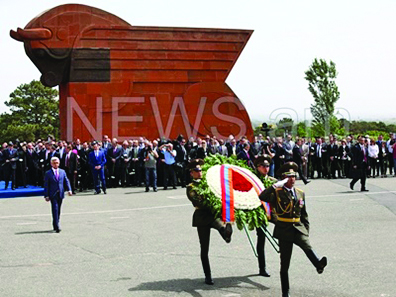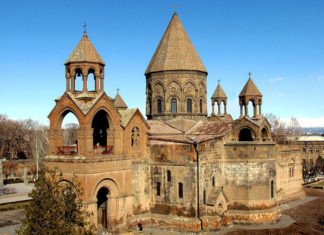 By Robert Fisk
By Robert Fisk
The ‘Liberation’ Mosque is a fine, neo-classical, almost Gothic construction with striped black-and-white stone banding, unusual for a Muslim holy place but a jewel in the Tepebasi district of the old town of Gaziantep. Its stone carvings and mock Grecian columns beside the window frames are a credit to another, gentler age. The minarets perch delicately — and I had never seen this before — on square towers that might have been church towers had there been Christians in this ancient city.
But of course, there were. What no-one will tell you in Gaziantep, what no guidebook mentions, what no tourist guide will refer to, is that this very building — whose 19th century builders were none other than the nephews of the official architect of Sultan Abdulhamid II — was the Holy Mother of God cathedral for at least 20,000 Christian Armenians who were victims of the greatest war crime of the 1914-18 war: the Armenian genocide. They were deported by the Ottoman Turks from this lovely city, which had been their families’ home for hundreds of years, to be executed into common graves. The murderers were both Turks and Kurds.
Altogether, up to 32,000 Armenians — almost the entire Christian population of 36,000 of what was then called Antep — were deported towards the Syrian cities of Hama, Homs, Selimiyeh, to the Hauran and to Deir Ezzor in 1915. The Muslim citizens of Aintep then apparently plundered the empty homes of those they had dispossessed, seizing not only their property but the treasures of the cathedral church itself. Indeed, the church, Surp Asdvazdadzin Kilisesi in Armenian, was turned into a warehouse — as were many Jewish synagogues in Nazi Germany and in Nazi-occupied eastern Europe during the Second World War — and then into a prison.
Prowling around the church-mosque enclosure, I found some of the prison bars still attached to the window frames, although the building has been functioning as a mosque since 1986. The main gate was closed but I pushed it open and found not only that the structure of the magnificent building is still intact but that scaffolding has been placed against the walls for a renovation. Behind the church – and separate from the building – was an ancient stone cave whose interior was blackened with what must have been the smoke of candle flames from another era, perhaps a worshipping place because the cave appears to have been a tomb in antiquity. The caretaker came fussing up to us to tell us that the mosque was shut, that we must leave, that this was a closed place. But he was a friendly soul and let us take pictures of the great façade of the church and of the minarets.
The only sign of its origin is the date “1892” carved in stone on the east façade of the original church, marking the final completion of the work of the great Armenian architect Sarkis Balian – he was the official architect of the 19th century Sultan Abdulhamid II, a terrible irony since Abdulhamid himself began the first round of Armenian massacres of 80,000 Christians (the figure might be 300,000) in Ottoman Turkey just two years after the Armenian stonemason Sarkis Tascian carved the date on the façade. In the later 1915 Armenian Holocaust – even Israelis use this word for the Armenian genocide – a million and a half Armenians were slaughtered by the Turks. It is a shock to realize that Aintep’s vast toll of dead were only a small fraction of this terrifying war crime.








